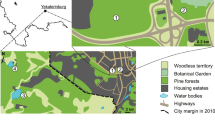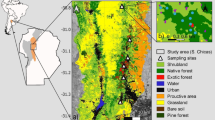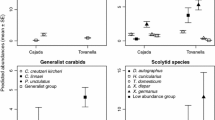Abstract
The influence of environmental parameters on epigeic beetle communities of forest fragments in an urbanization gradient was studied in Berlin. Eight deciduous forests along a rural to urban gradient were sampled with pitfall traps. Species richness did not decline across the rural to urban gradient. As expected, impervious surface cover as an indicator of urbanization correlated not only with habitat fragmentation and heat island effect but also with altered soil properties. The proportion of forest specialist staphylinid species decreased with increasing urbanization. The differences between staphylinid communities of neighboring forest fragments were enhanced in the most urban parts, probably due to increased habitat fragmentation. Furthermore, the loss of flightless species with increasing habitat isolation emphasized the influence of habitat fragmentation. The carabid communities revealed the urbanization effects not as clearly as the staphylinid communities, but both taxa revealed that direct anthropogenic habitat alteration, indicated by removal of decaying wood, favors open-habitat specialists. The extent of the urbanization influence seems to vary seasonally. Environmental parameters associated with urbanization explain the ordination of species communities in the winter better than in the summer. Heat island effect is suggested as an explanation for this difference.
Similar content being viewed by others
References
Alaruikka D, Kotze DJ, Matveinen K, Niemelä J (2003) Carabid beetle and spider assemblages along a forested urban-rural gradient in southern Finland. Journal of Insect Conservation 6:195–206
Anthrop M (2000) Changing patterns in the urbanized countryside of Western Europe. Landscape Ecology 15:257–270
Arnold CL, Gibbons C (1996) Impervious surface coverage: The emergence of a key environmental indicator. Journal of the American Planning Association 62(2):243–258
Assing V (1992) Die Kurzflügelkäfer (Coleoptera: Staphylinidae) eines urbanen Inselbiotopkomplexes in Hannover. 3. Beitrag zur Faunistik und Ökologie der Staphyliniden von Hannover. Berichte der Naturhistorischen Gesellschaft Hannover 134:173–187
Barndt D, Brase S, Glauche M, Gruttke H, Kegel B, Platen R, Winkelmann H (1991) Die Laufkäferfauna von Berlin (West)—mit Kennzeichnung und Auswertung der verschollenen und gefährdeten Arten. In: Rote Listen der gefährdeten Pflanzen und Tiere in Berlin. Auhagen A, Platen R, Sukopp H, (eds.), Extra volume S6 of: Landschaftentwicklung und Umweltforschung. Technical University Berlin, pp. 243–275
Basedow T, Rzehak H, Dickler E (1990) Untersuchungen zur Flugaktivität epigäischer Raubarthropoden mittels Licht- und Fensterfallen. Mitteilungen der Deutschen Gesellschaft für Allgemeine und Angewandte Entomologie 7:386–394
Bolger DT, Suarez AV, Crooks KR, Morrison SA, Case TJ (2000) Arthropods in urban habitat fragments in southern California: Area, age, and edge effects. Ecological Applications 10(4):1230–1248
Coleman DC, Crossley DA, Jr. Hendrix PF (2004) Fundamentals of Soil Ecology. Elsevier Academic Press, Amsterdam
Colwell RK (2004) EstimateS: Statistical estimation of species richness and shared species from samples. Version 7. Available at http://purl.oclc.org/estimates
Czechowski W (1982) Occurence of carabids (Coleoptera, Carabidae) in the urban greenery of Warsaw according to the land utilization and cultivation. Memorabilia Zoologica 39:3–108
Davis BNK (1982) Habitat diversity and invertebrates in urban areas. In: Urban Ecology. Bornkamm R, Lee JA, Seaward MRD (eds) Blackwell, Oxford, pp. 75–82
Desender K, Dufrene M, Loreau M, Luff ML, Maelfait JP (eds) (1994) Carabid Beetles—Ecology and Evolution. Kluwer Academic Publishers, Dordrecht
Faeth SH, Kane TC (1978) City parks as Islands for Diptera and Coleoptera. Oecologia 32:127–133
Gibb H, Hochuli DF (2002) Habitat fragmentation in an urban environment: large and small fragments support different arthropod assemblages. Biological Conservation 106(1):91–100
Gibbs JP, Stanton EJ (2001) Habitat fragmentation and arthropod community change: Carrion beetles, phoretic mites, and flies. Ecological Applications 11(1):79–85
Grandchamp A-C, Niemelä J, Kotze DJ (2000) The effects of trampling on assemblages of ground beetles (Coleoptera, Carabidae) in urban forests in Helsinki, Finland. Urban Ecosystems 4:321–332
Gotelli NJ, Colwell RK (2001) Quantifying biodiversity: procedures and pitfalls in the measurement and comparison of species richness. Ecology Letters 4:379–391
Halme E, Niemelä J (1993) Carabid beetles in fragments of coniferous forest. Annales Zoologici Fennici 30:17–30
Hupfer P, Chmielewski F-M (1990) (eds) Das Klima von Berlin. Akademie Verlag, Berlin
Irmler U (1998) Die vertikale Verteilung flugaktiver Käfer (Coleoptera) in drei Wäldern Norddeutschlands. Faunistisch-Ökologische Mitteilungen 7:387–404
Irmler U (2001) Bedeutung urbaner Brachen für Laufkäfer (Carabidae). Faunistisch-Ökologische Mitteilungen 8:135–145
Ishitani M, Kotze DJ, Niemelä J (2003) Changes in carabid beetle assemblages across an urban-rural gradient in Japan. Ecography 26:481–489
Klausnitzer B, Richter K (1983) Presence of an urban gradient demonstrated for carabid associations. Oecologia 59:79–82
Klazenga N, de Vries HH (1994) Walking distances of five differently sized ground beetle species. Proceedings of the Section Experimental and Applied Entomology of the Netherlands Entomological Society 5:99–100
Korge H (1991) Liste der Kurzflügelkäfer (Coleoptera, Staphylinidae) von Berlin (West) mit Kennzeichnung der verschollenen und gefährdeten Arten (Rote Liste). In: Rote Listen der gefährdeten Pflanzen und Tiere in Berlin. Auhagen A, Platen R, Sukopp H, (eds.) Extra volume S6 of: Landschaftentwicklung und Umweltforschung. Technical University, Berlin, pp. 277–317
Kühn I, Brandl R, Klotz S (2004) The flora of German cities is naturally species rich. Evolutionary Ecology Research 6:749–764
Landgrebe D, Biehl L (2005) MULTISPEC- A Freeware Multispectral Image Data Analysis System. Available at http://dynamo.ecn.purdue.edu/~sim$biehl/MultiSpec/Index.html
Landsberg H (1981) The Urban Climate. In: International Geophysics Series, Vol 28, New York
Mader H-J (1980) Die Verinselung der Landschaft aus tierökologischer Sicht. Natur und Landschaft 55:91–96
Magura T, Ködöböcz V, Tóthmérész B (2001) Effects of habitat fragmentation on carabids in forest patches. Journal of Biogeography 28:129–138
Magura T, Tóthmérész B, Molnár T (2004) Changes in carabid beetle assemblages along an urbanisation gradient in the city of Debrecen, Hungary. Landscape Ecology 19:747–759
Magurran AE (1988) Ecological Diversity and its Measurement. Princeton University Press, Princeton
Markgraf A, Basedow T (2002) Flight activity of predatory Staphylinidae in agriculture in central Germany. Journal of Applied Entomology 126:79–81
McDonell MJ, Pickett STA, Groffman P, Bohlen P, Poyat RV, Zipperer WC, Parmelee RW, Carreiro MM, Medley K (1997) Ecosystem processes along an urban-to-rural gradient. Urban Ecosystems 1:21–36
Miyashita T, Shinkai A, Chida T (1998) The effects of forest fragmentation on web spider communities in urban areas. Biological Conservation 86:357–364
Mueller-Dombois D, Ellenberg H (1974) Aims and Methods of Vegetation Ecology. John Wiley & Sons, New York-London-Sydney-Toronto
Niemelä J, Kotze DJ, Ashworth A, Brandmayr P, Desender K, New T, Penev L, Samways M, Spence J (2000) The search for common anthropogenic impacts on biodiversity: a global network. Journal of Insect Conservation 4:3–9
Niemelä J (2001) Carabid beetles (Coleoptera: Carabidae) and habitat fragmentation: a review. European Journal of Entomology 98:127–132
Niemelä J, Kotze DJ, Venn S, Penev L, Stoyanov I, Spence J, Hartley D, Montes de Oca E, (2002) Carabid beetle assemblages (Coleoptera, Carabidae) across urban-rural gradients: an international comparison. Landscape Ecology 17:387–401
Oksanen J, Kindt R, O'Hara B (2005) Vegan—Community Ecology Package. Available at http://cc.oulu.fi/~sim$jarioksa/
R Development Core Team (2005) R: A language and environment for statistical computing. R Foundation for Statistical Computing, Vienna, Austria. Available at http://www.R-project.org
Schaefer M, Kock K (1979) Zur Ökologie der Arthropodenfauna einer Stadtlandschaft und ihrer Umgebung. I. Laufkäfer (Carabidae) und Spinnen (Araneida). Anzeiger für Schädlingkunde, Pflanzenschutz, Umweltschutz 52:85–90
Shochat E, Stefanov WL, Whitehouse MEA, Faeth SH (2004) Urbanization and Spider Diversity: Influences of Human Modification of Habitat Structure and Productivity. Ecological Applications 14:268–280
StatSoft (2001) Statistica for Windows 6.0. Tulsa, Oklahoma
Szyszko J, Den Boer PJ, Bauer T, (eds) (2002) How to protect or what we know about Carabid Beetles. Warsaw Agricultural University Press, Warsaw
Thiele H-U (1977) Carabid beetles in their environments. Springer, Berlin-Heidelberg-New York
Tonteri T, Haila Y (1990) Plants in a boreal city: ecological characteristics of vegetation in Helsinki and its surroundings, southern Finland. Annales Botanici Fennici 27:337–352
Tscharntke T, Brandl R (2004) Plant-Insect Interactions in Fragmented Landscapes. Annual Review of Entomology 49:405–430
UEIS (2005) Berlin Urban and Environmental Information System. Available at http://www.stadtentwicklung.berlin.de/umwelt/umweltatlas/edua_index.shtml
Usher MB, Field J, Bedford S (1993) Biogeography and diversity of ground-dwelling arthropods in farm woodlands. Biodiversity Letters 1:54–62
Vernon P, Vannier G (2002) Evolution of freezing susceptibility and freezing tolerance in terrestrial arthropods. Comptes Rendus Biologies 325(12):1185–1190
Weller B, Ganzhorn JU (2004) Carabid beetle community composition, body size, and fluctuating asymmetry along an urban-rural gradient. Basic and Applied Ecology 5:193–201
Author information
Authors and Affiliations
Corresponding author
Rights and permissions
About this article
Cite this article
Deichsel, R. Species change in an urban setting—ground and rove beetles (Coleoptera: Carabidae and Staphylinidae) in Berlin. Urban Ecosyst 9, 161–178 (2006). https://doi.org/10.1007/s11252-006-8588-3
Published:
Issue Date:
DOI: https://doi.org/10.1007/s11252-006-8588-3




